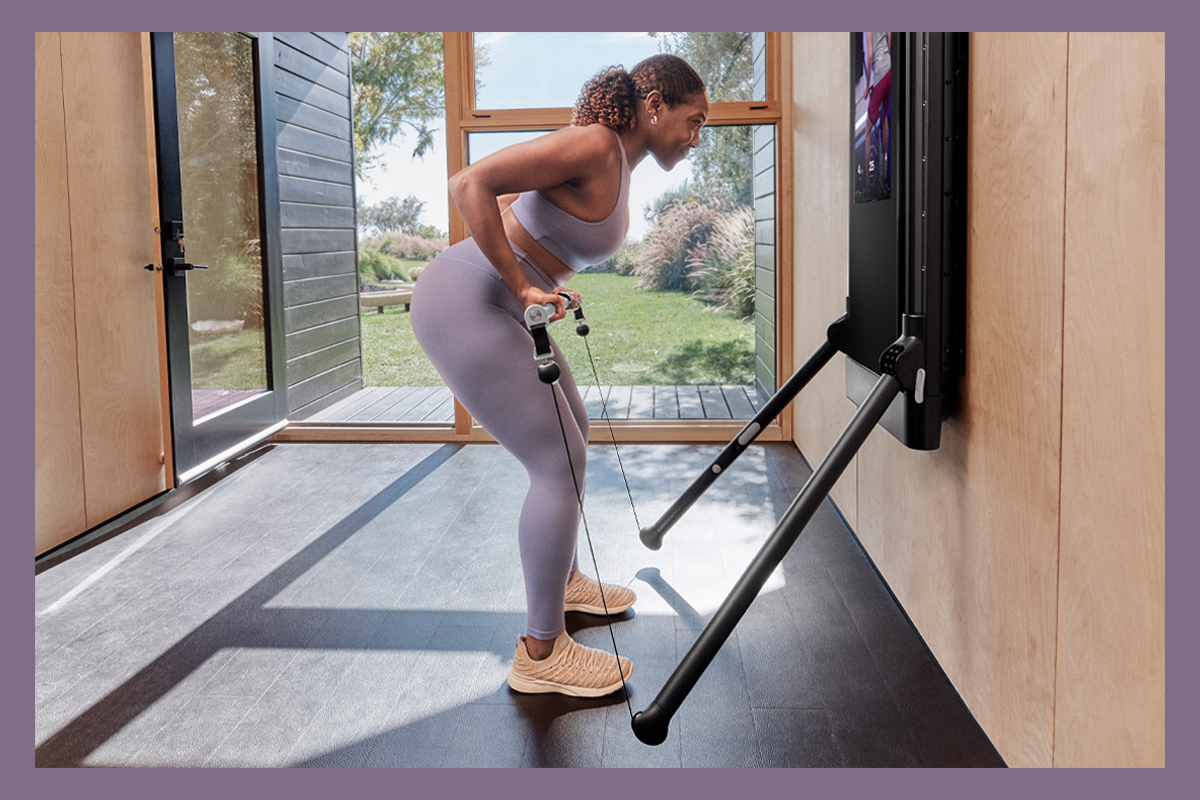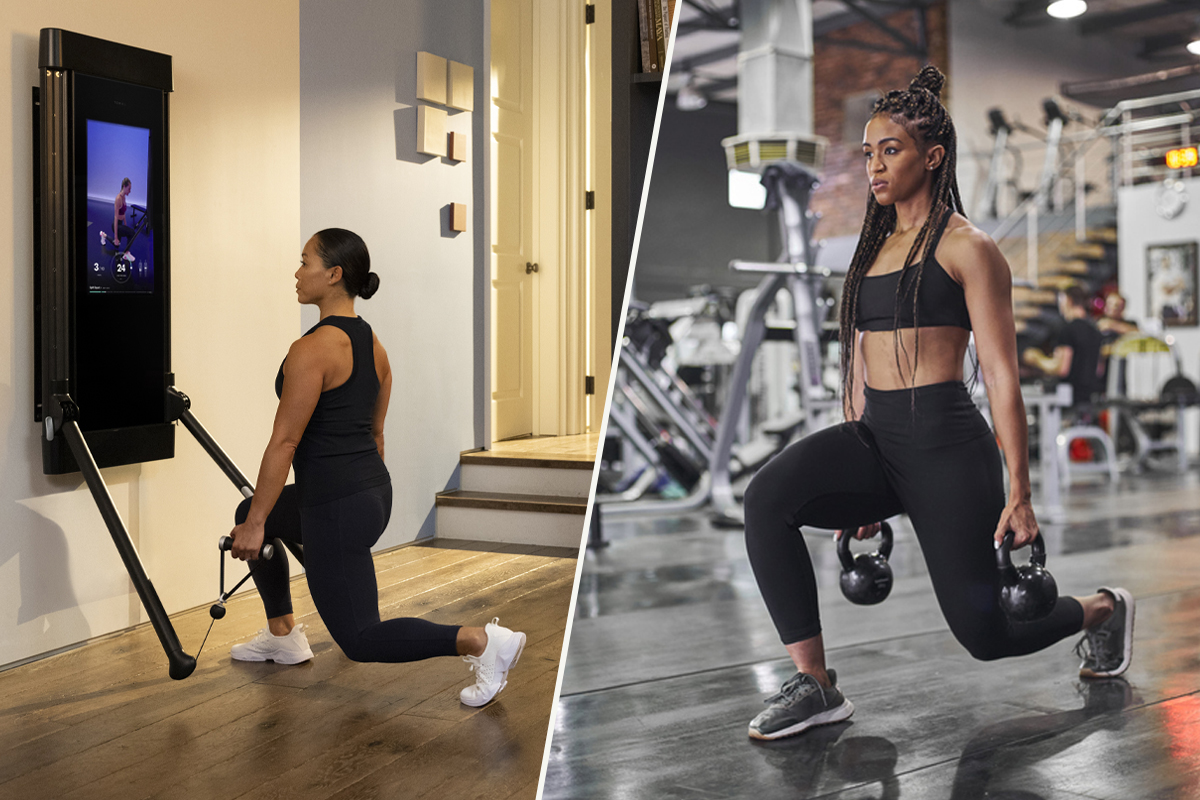Both types of exercise deserve a place in your routine. Here’s why.
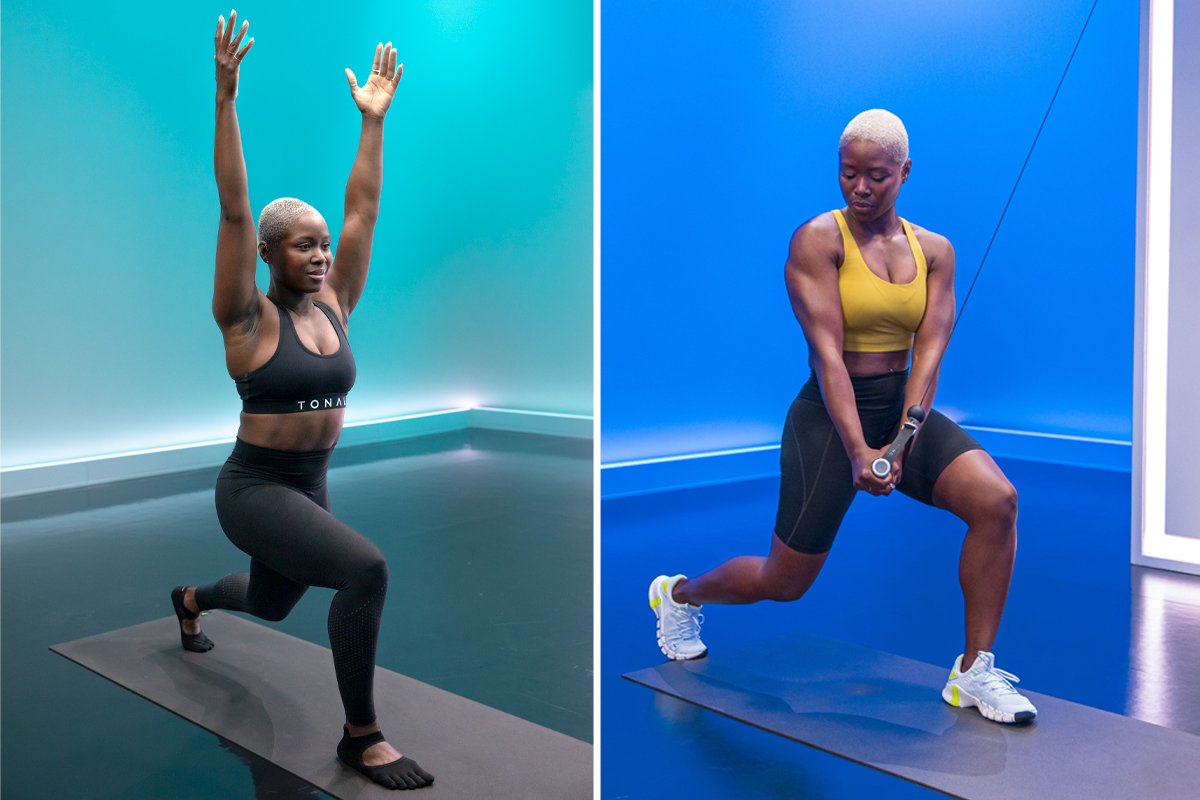
Pilates is a low-impact exercise that boosts core strength, mobility, and flexibility, so it’s not surprising that the practice is popular among those who want to lengthen and tone their frame or simply mix things up. Pilates can even improve your performance in other workouts, like resistance training.
Here, Tonal coach and personal trainer Tanysha Renee, who is certified in Pilates-inspired Lagree Fitness, breaks down the differences and similarities between Pilates and strength training, and explains how you can use both to achieve your goals.
What is Pilates?
Originally developed by physical trainer Joseph Pilates, Pilates is now a broad group of low-impact exercises that includes movements done on a mat with your body weight or using equipment, such as a reformer, that incorporates external resistance through springs. Pilates workouts emphasize core strength and stability, posture, movement precision, and breath control.
Even if you’ve never taken a Pilates class, you might recognize certain moves—like lunges, planks, and core work—from yoga, physical therapy, or the warmups and cooldowns in your strength training workouts. That’s because Pilates improves flexibility and range of motion, both of which are beneficial for all types of fitness goals.
Pilates vs. Strength Training: The Methods
When you’re used to repping out biceps curls or bench presses, the slow tempo of a Pilates workout may surprise you—but that doesn’t mean it’s easier or less effective. “Your time under tension is a lot longer,” says Renee. “You’ll be in a lot of the moves for 60 seconds up to two minutes, whereas in strength training you end up being in a movement for a matter of seconds.”
In Pilates, you’ll often focus on the eccentric, or lowering, phase of a movement in which your muscles are in a lengthened position. This type of exercise has been proven to improve flexibility, one of the main focuses of Pilates.
“Pilates takes you through a broader range of motion with a lighter load,” says Renee. In a typical Pilates class, you might do moves like leg lifts, bicycle crunches, or roll-ups (a type of sit-up). Even when the exercise you’re performing doesn’t target your core directly, a Pilates instructor will typically remind you to engage your core muscles to support the rest of your body.
Effective strength training, on the other hand, is based on the principle of progressive overload or systematically changing stimulus (often resistance or volume) to induce stress and force your muscles to adapt.
Pilates vs. Strength Training: The Results
The main benefits of Pilates are increased flexibility and mobility. Renee says that over months or years of Pilates practice, you’ll find you’re able to get much deeper into moves like lunges.
That’s not to say you won’t get stronger from Pilates. “The muscles are being overloaded because of the time [under tension] and the tempo, not necessarily the load,” says Renee. Your strength will improve even from bodyweight moves, but eventually, you’ll hit a plateau unless you start adding external resistance.
With strength training, Renee says, “you’re adding greater load so you’ll be able to have greater output.” Lifting additional resistance gives you more potential for improvement in muscle strength, size, and power.
Even if Pilates is your main form of exercise, Renee stresses the importance of incorporating some resistance training, especially as you age. “The bones and muscles still need to be challenged as we’re aging and bone density is decreasing,” she says. “It’s harder to do that in a mat-based Pilates class.” Lifting heavier loads offers more bone health benefits, including reducing the risk of osteoporosis.
Pilates vs. Strength Training: Weight Loss
Pilates may be appealing, especially to women, because it’s believed that it creates “long and lean” bodies with toned muscles and less fat. While losing weight and getting lean largely comes down to maintaining a calorie deficit—not any specific type of exercise—strength training actually has an edge if that’s your goal.
“Strength training would be where I’d put my time and attention because you’re getting more bang for your buck,” says Renee. One reason is that lean muscle is very metabolically active, meaning it burns more calories than fat. As you gain lean muscle through strength training, you boost your resting metabolic rate, increasing the number of calories you burn as you go about your day, even when you’re just sitting on the couch.
Strength training workouts often feature compound movements that involve multiple joints and muscles. These exercises are efficient because they recruit more muscles in less time. In Pilates, exercises may be more isolated to a small, specific movement. Recruiting large muscles burns more calories and creates more lean muscle mass.
How to Combine Pilates and Strength Training
According to Renee, Pilates is a great complement to strength training. Studies have shown that working at a range of intensities and rep ranges is beneficial for your muscles. Therefore, if you’re including both heavy-resistance, low-rep weight lifting, and lower-resistance, high-rep Pilates in your weekly routine, you’ll enjoy the benefits of both types of training.
Practicing Pilates promotes mobility, which will help with your lifting. “Pilates is going to help your strength training because you are getting the body to go through a deeper range of motion that it doesn’t always experience in strength training,” she says. Additionally, the core strength and stability you gain in Pilates can support your performance in big compound lifts, such as front squats.
If you’re new to both forms of exercise, she recommends starting with 2 to 3 days of working out per week, evenly split between the two disciplines. Once you’re more experienced, you can increase the number of days per week for each. Keep in mind, though, that Pilates can be fatiguing due to the high time under tension and accessory work that might challenge small muscles you’re not used to working. Therefore, it’s best to add a rest day after a Pilates workout and before lifting heavy to give your body time to recover.
Try These Pilates Moves
These mat-based Pilates exercises can easily be done from home without any equipment. While they may look simple, the focus on movement precision in Pilates means that subtle form adjustments can make a big difference. Try a Pilates workout on Tonal to get expert guidance, or follow Coach Tanysha’s recommendations below.
Pillar Bridge

Why it Works: Renee says this plank variation is a “classic for a reason” because it targets the core muscles that create a strong foundation for nearly all our other movements.
How to Do it: Get onto your mat facing the floor with both elbows under your shoulders and feet hip distance apart, toes tucked. Lift the knees to extend the legs and push the floor away from you through your elbows.
Runners Lunge
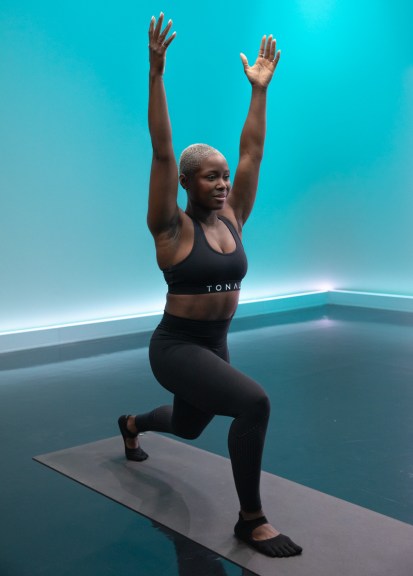
Why it Works: Tight hip flexors are incredibly common, and this is Renee’s top pick for improving mobility and flexibility in the hips. “We’re always seated in front of the computer or TV,” she says, “so getting in something to open up the hips is a great movement.”
How to Do it: Get into a low lunge position with your front foot planted and your back leg extended behind you, knee on the floor, and your toes tucked. Place your hands on the floor inside the front leg, shoulder-width apart. Lift your back knee slowly to straighten your back leg and lift the back of the knee toward the ceiling. Relax your knee back down to the floor and repeat.
Downward Dog
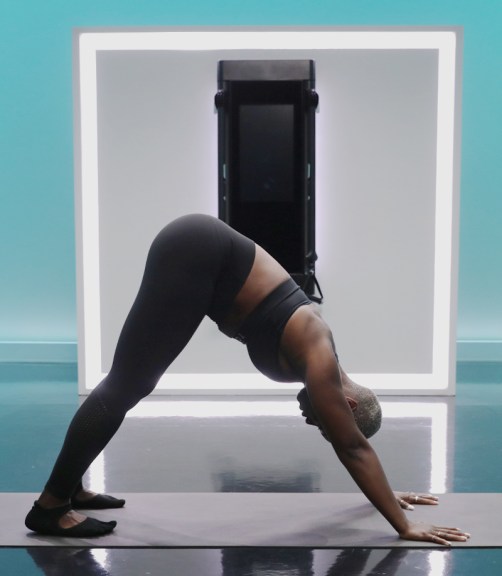
Why it Works: Like the runners lunge, downward dog works to counteract the effects of spending all day seated—specifically by addressing the back of the body and posterior chain. “You need to drive your heels into the ground as you actively press your hands into the ground,” says Renee. “You’re getting this extension of the body that helps with posture in the long run.”
How to Do it: Place your hands on the mat, shoulder-width apart, with legs extended behind you, toes tucked, and eyes looking toward your feet. Drive your hips up to the ceiling creating a triangle, lowering your heels to the mat.
Superhero Iso Hold

Why it Works: Another excellent movement for the back body, this isometric hold challenges your back muscles which are often weak from spending hours hunching forward.
How to Do it: Lie face down on your mat. Extend your arms upward and out about 45 degrees from your head. Extend your legs about hip distance apart. Imagine strings from the ceiling lifting all 4 limbs off the floor while you balance on your pelvis and low belly. With your back and glutes engaged, hold here.
Pilates Saw
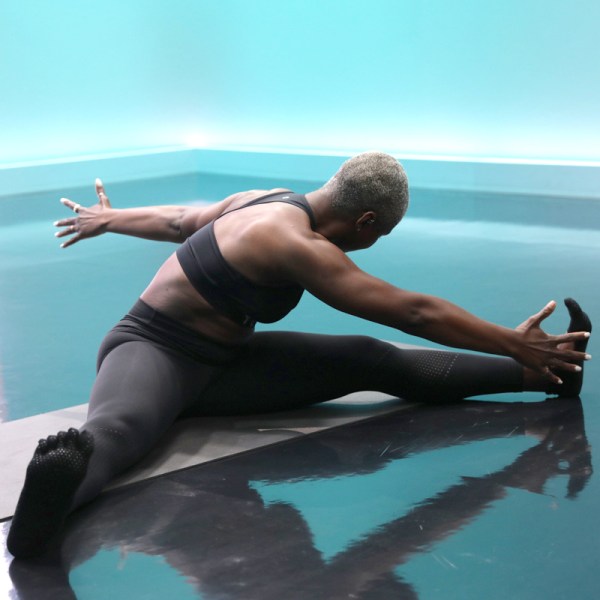
Why it Works: Renee likes this move as it encourages trunk stability since you’re trying to keep your torso stable as you stretch. “As you rotate the opposite hand to the opposite leg, you exhale so you get a stretch in the upper back but also in the hamstrings,” she says.
How to Do it: Sit up straight on your mat with your legs extended hips-distance apart, balancing your weight on your pelvis. Lift your arms to the side, shoulder-height with your palms facing forward. Twist your torso to face your right leg and lower your left hand towards your right foot. Return to center and repeat on the opposite side.
Side Bends
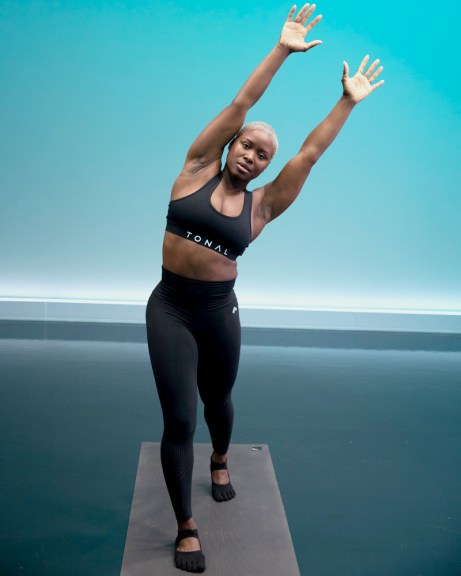
Why it Works: This simple move might bring you back to middle school gym class, but Renee loves how it stretches out the torso.“You get that full extension in the whole side of the back and torso,” she says.
How to Do it: Stand tall in a staggered stancewith arms overhead and palms facing each other. With legs straight, bend from the hip to the right lowering your right arm and side body toward the ground. Return to center and repeat on the opposite side.

